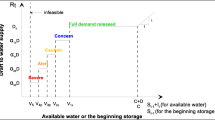Abstract
Drought-induced shortages are inevitable because of unexpected abnormal dry weather and the increasing need for water resources. Therefore, assessment of possible shortage conditions for a specific water supply system is an essential component in water resources planning and management. In this study, the shortage characteristics for the Shihmen Reservoir in Taiwan are investigated. A description of the reservoir yield in terms of the shortage frequency, magnitude, and duration is developed first. The derived reservoir yield description under a given operating policy and demand includes the reliability, total shortage rate, frequency, single period shortage, event shortage duration and magnitude, and interarrival time of shortage events. Hedging is a common measure adopted in reservoir operation that involves accepting a small current deficit to reduce future severe shortages. The reservoir supply index is then developed to trigger hedging in this study. The shortage characteristics for different lead-time hedging rules show that the derived reservoir supply index is a useful indicator for triggering hedging and the differences among reservoir performance for various release policies are easily compared using the derived reservoir yield description in terms of probabilistic shortage characteristics.
Similar content being viewed by others
References
Bayazit, M. and Unal, N. E.: 1990, ‘Effects of hedging on reservoir performance’, Water Resour. Res. 26(4), 713–719.
Cancelliere, A., Ancarani, A. and Rossi, G.: 1998, ‘Susceptibility of water supply reservoir to drought conditions’, J. Hydrologic Engng., ASCE, 3(2), 140–148.
Hashimoto, H., Stedinger, J. R. and Loucks, D. P.: 1982, ‘Reliability, resiliency, and vulnerability criteria for water resources system performance evaluation’, Water Resour. Res. 18(1), 14–20.
Hrezo, M. S., Bridgeman, P. G. and Walker, W. R.: 1986, ‘Managing drought through triggering mechanisms’, J. Am. Water Works. Assoc. 78(6), 46–51.
Kung, C. S. and Liao, Y. C.: 2002, ‘Establishment of drought monitoring system for Shihemen Rreservoir’, J. Water Resour. Managt. 4(3), 27–33 (in Chinese).
Lee, T. M. and Su, J. M.: 2002, ‘Water rationing measures of Shihmen Reservoir in 2002 drought’, J. Water Resour. Managt. 4(3), 16–26 (in Chinese).
Linsley, R. T., Franzini, J. B., Freyberg, D. L. and Tchobanoglous, G.: 1992, Water-Resources Engineerning, 4th Ed., McGraw Hill Inc., New York, U.S.A.
Lund, J. R. and Reed, R. U.: 1995, ‘Drought water rationing and transferable rations’, J. Water Resour. Plant. Managt., ASCE 121(6), 429–437.
Maass, A., Hufschmidt, M. M., Dorfman, R., Thomas Jr., H. A., Marglin, S. A. and Fair, G. M.: 1962, Design of Water Resources System, Harvard University Press, Cambridge, Mass., U.S.A.
Neelakantan, T. R. and Pundarikanthan, N. V.: 1999, ‘Hedging rule optimization for water supply reservoir system’, Water Resour. Managt. 13(6), 409–426.
Salas, J. D., Delleur, J. W., Yevjevich, V. and Lane, W. L.: 1988, Applied Modeling of Hydrologic Time Series, Water Resources Publications, Fort Collins, Colo., U.S.A.
Shiau, J. T. and Shen, H.W.: 2001, ‘Recurrence analysis of hydrologic droughts of differing severity’, J. Water Resour. Plant. Managt., ASCE 127(1), 30–40.
Shih, J. S. and ReVelle, C.: 1995, ‘Water supply operations during drought: a discrete hedging rule’, European J. Operat. Res. 82, 163–175.
Shih, J. S. and ReVelle, C.: 1994, ‘Water-supply operations during drought: continuous hedging rule’, J. Water Resour. Plant. Managt., ASCE 120(5), 613–629.
Srinivasan, K. and Philipose, M. C.: 1996, ‘Evaluation and selection of hedging policies using stochastic reservoir simulation’, Water Resour. Managt. 10(3), 163–188.
Srinivasan, K. and Philipose, M. C.: 1998, ‘Effect of hedging on over-year reservoir performance’, Water Resour. Managt. 12(2), 95–120.
Tickle, K. and Goulter, I. C.: 1992, ‘Assessment of Performance Metrics for a Reservoir under Stochastic Conditions’, in Proceedings of the 6th IAHR International Symposium on Stochastic Hydraulics, Taipei, pp. 583–590.
Water Resources Agency (WRA): 2002, Planning Decision Support System for Drought Defense, Water Resources Agency, Taiwan (in Chinese).
Wilhite, D. A.: 1993, The Enigma of Drought, in D. A. Wilhite (ed.), Drought Assessment, Management and Planning: Theory and Case Studies, Kluwer Academic Publishers, pp. 3–15.
Xu, Z., Jinno, K., Kawamura, A., Takesaki, S. and Ito, K.: 1998, Performance risk analysis for Fukuoka water supply system, Water Resour. Managt. 12(1), 13–30.
Yevjevich, V.: 1967, ‘An Objective Approach to Definitions and Investigations of Continental Hydrologic Droughts’, Hydrology Paper No.23, Colorado State Univ., Fort Collins, Colo., U.S.A.
Author information
Authors and Affiliations
Rights and permissions
About this article
Cite this article
Shiau, J.T. Water Release Policy Effects on the Shortage Characteristics for the Shihmen Reservoir System during Droughts. Water Resources Management 17, 463–480 (2003). https://doi.org/10.1023/B:WARM.0000004958.93250.8a
Issue Date:
DOI: https://doi.org/10.1023/B:WARM.0000004958.93250.8a




